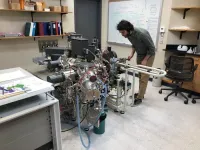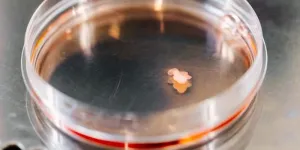How do plants determine where the light is coming from ?
2023-11-23
(Press-News.org)
Plants have no visual organs, so how do they know where light comes from? In an original study combining expertise in biology and engineering, the team led by Prof Christian Fankhauser at UNIL, in collaboration with colleagues at EPFL, has uncovered that a light-sensitive plant tissue uses the optical properties of the interface between air and water to generate a light gradient that is 'visible' to the plant. These results have been published in the journal Science.
The majority of living organisms (micro-organisms, plants and animals) have the ability to determine the origin of a light source, even in the absence of a sight organ comparable to the eye. This information is invaluable for orienting oneself or optimal positioning in the environment. Perceiving where light is coming from is particularly important for plants, which use this information to position their organs, a phenomenon known as phototropism. This enables them to capture more of the sun's rays, which they then convert into chemical energy through the process of photosynthesis, a vital process which is necessary for the production of nearly all of the food we eat.
Although the photoreceptor that initiates phototropism has long been known, the optical properties of photosensitive plant tissue have until now remained a mystery. A multidisciplinary study published in Science, combining the expertise of the teams of DrSc. Christian Fankhauser (full professor and director of the Integrative Genomics Centre in the Faculty of Biology and Medicine at UNIL), DrSc. Andreas Schüler (head of the Nanotechnology for Solar Energy Conversion group at EPFL's Solar Energy and Building Physics Laboratory) and UNIL's Electron Microscopy Centre uncovered a surprising tissue feature allowing plants to detect directional light cues.
"It all started with the observation of a mutant of the model species Arabidopsis thaliana, the thale cress, whose stem was surprisingly transparent", explains Christian Fankhauser, who led the research. These plants failed to respond to light correctly. The UNIL biologist then decided to call on the skills of his colleague Andreas Schüler from EPFL, in order to further compare the specific optical properties of the mutant versus wild type samples. "We found that the natural milky appearance of the stems of young wild plants was in fact due to the presence of air in intercellular channels precisely located in various tissues. In the mutant specimens, the air is replaced by an aqueous liquid, giving them a translucent appearance", continues the researcher.
But what purpose do such air-filled channels serve? They enable the photosensitive stem to establish a light gradient that can be "read" by the plant. The plant can then determine the origin of the light source. This phenomenon is due to the different optical properties of air and water, which make up the majority of living tissue. “More specifically, air and water have different refractive indices. This leads to light scattering as it passes through the seedling. We have all observed this phenomenon when admiring a rainbow", explains Martina Legris, a postdoctoral fellow in Prof Fankhauser's group and co-first author of the study.
Thanks to their research, the scientists have revealed a novel mechanism that enables living organisms to perceive where the light is coming from, enabling them to position their organs such as leaves in a way that optimizes light capture for photosynthesis. The study also provided a better understanding of the formation of air-filled intercellular channels, which have a range of functions in plants, in addition to the formation of light gradients. Among other uses, these channels promote gas exchange and also make it possible to resist hypoxia (reduction in the quantity of oxygen) in the event of flooding. Their development from the embryonic stage to adulthood, is still very poorly understood. Genetic resources used in this study will be useful to better understand the formation and maintenance of these intriguing structures.
END
ELSE PRESS RELEASES FROM THIS DATE:
2023-11-23
E. coli bacteria may be far more capable at evolving antibiotic resistance than scientists previously thought, according to a new study published in Science on November 24.
Led by SFI External Professor Andreas Wagner, the researchers experimentally mapped more than 260,000 possible mutations of an E. coli protein that is essential for the bacteria’s survival when exposed to the antibiotic trimethoprim.
Over the course of thousands of highly realistic digital simulations, the researchers then found that 75% of all possible evolutionary paths of the E. coli protein ultimately ...
2023-11-23
Blame it on plate tectonics. The deep ocean is never preserved, but instead is lost to time as the seafloor is subducted. Geologists are mostly left with shallower rocks from closer to the shoreline to inform their studies of Earth history.
“We have only a good record of the deep ocean for the last ~180 million years,” said David Fike, the Glassberg/Greensfelder Distinguished University Professor of Earth, Environmental, and Planetary Sciences in Arts & Sciences at Washington University in St. Louis. “Everything else is just shallow-water deposits. So it’s really important to understand the bias that might be present when we look ...
2023-11-23
Addressing the long-standing “dolomite problem,” an oddity that has vexed scientists for nearly 200 years, researchers report that dolomite crystals require cycling of saturation conditions to grow. The findings provide new insights into how dolomite is formed and why modern dolomite is primarily found in natural environments with pH or salinity fluctuations. Dolomite – a calcium magnesium carbonate – is one of the major minerals in carbonate rocks, accounting for nearly 30% of the sedimentary carbonate minerality in Earth’s crust. However, despite its geological abundance, dolomite does not readily grow under laboratory conditions, ...
2023-11-23
Using a new algorithm called FLSHclust (“flash clust”), researchers have discovered 188 rare and previously unknown CRISPR-linked gene modules – including a novel type VII CRISPR-Cas system – among billions of protein sequences. The approach and its findings provide novel opportunities for harnessing CRISPR systems and understanding the vast functional diversity of microbial proteins. CRISPR systems have been leveraged to develop a growing suite of novel biomolecular approaches, including CRISPR/Cas-mediated genome editing. The discovery ...
2023-11-23
An extremely energetic cosmic ray – an extragalactic particle with an energy exceeding ~240 exa-electron volts (EeV) – has been detected by the Telescope Array experiment’s surface detector, researchers report. However, according to the findings, its arrival direction shows no obvious source. Ultrahigh-energy cosmic rays (UHECRs) are subatomic charged particles from space with energies greater than 1 EeV – roughly a million times as high as the energy reached by human-made particle accelerators. Although low-energy cosmic rays primarily emanate from the sun, the origins of rarer UHECRs are thought to be related to the most energetic phenomena in the Universe, ...
2023-11-23
In 1991, the University of Utah Fly’s Eye experiment detected the highest-energy cosmic ray ever observed. Later dubbed the Oh-My-God particle, the cosmic ray’s energy shocked astrophysicists. Nothing in our galaxy had the power to produce it, and the particle had more energy than was theoretically possible for cosmic rays traveling to Earth from other galaxies. Simply put, the particle should not exist.
The Telescope Array has since observed more than 30 ultra-high-energy cosmic rays, though none approaching the Oh-My-God-level energy. No observations have yet revealed ...
2023-11-23
Images // Video
ANN ARBOR—For 200 years, scientists have failed to grow a common mineral in the laboratory under the conditions believed to have formed it naturally. Now, a team of researchers from the University of Michigan and Hokkaido University in Sapporo, Japan have finally pulled it off, thanks to a new theory developed from atomic simulations.
Their success resolves a long-standing geology mystery called the "Dolomite Problem." Dolomite—a key mineral in the Dolomite mountains in Italy, Niagara Falls, the White Cliffs of Dover and Utah's Hoodoos—is very abundant in rocks older than 100 million years, but nearly absent in younger ...
2023-11-23
Animal embryos go through a series of characteristic developmental stages on their journey from a fertilized egg cell to a functional organism. This biological process is largely genetically controlled and follows a similar pattern across different animal species. Yet, there are differences in the details – between individual species and even among embryos of the same species. For example, the tempo at which individual embryonic stages are passed through can vary. Such variations in embryonic development are considered an important driver of evolution, as they can lead to new characteristics, thus promoting evolutionary adaptations and biodiversity.
Studying the embryonic ...
2023-11-23
In a Nature Metabolism paper published today, researchers from the University of Pittsburgh detail a potential new target and a small-molecule drug candidate for treating Barth syndrome, a rare, life-threatening and currently incurable genetic disease with devastating consequences.
Barth syndrome affects about 1 in every 300,000 to 400,000 babies born worldwide. Those with the condition have weak muscles and hearts and experience debilitating fatigue and recurrent infections.
Pitt researchers discovered that faulty mitochondria are at least partially to blame, and identified a molecular culprit that could be targeted to potentially reverse the disease course in the future.
In ...
2023-11-23
A lot of research has been done over many decades on diseases that are widespread in large parts of the population, such as cancer and heart disease. As a result, treatment methods have improved enormously thanks to long-term research efforts on diseases that affect many people.
However, there are many diseases that affect just a handful people. These diseases often fly under the radar and are far less researched. They include quite a few rare, hereditary diseases, such as DOOR syndrome, which is ...
LAST 30 PRESS RELEASES:
[Press-News.org] How do plants determine where the light is coming from ?


